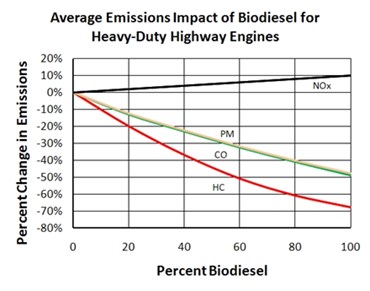Biodiesel Quick Facts
- Biodiesel is a domestically produced, renewable fuel that can be used instead of petroleum-based diesel.
- This fuel can be made from vegetable oils, animal fats, or recycled restaurant grease. It is also nontoxic and biodegradable.
- Biodiesel is typically used as a blend of both petroleum diesel and biodiesel. Pure biodiesel is referred to as B100.
- The percent oxygen in biodiesel is about 10-12% higher than in regular petroleum diesel, resulting in reduced pollution. There is also a very low level of sulfur, which decreases air pollutants as well.
- WATCH: Biodiesel Basics
- Read more: Biodiesel Fact Sheet
Biodiesel Stations
Use the Alternative Fuels Data Center’s Station Locator to find public biodiesel stations in Virginia.
Locations are subject to change, so we recommend calling the stations to verify location, hours of operation, and access.
Biodiesel stations have very similar infrastructure to conventional diesel stations. Blends up to B20 can be dispensed with the same pumps and stored in the same tanks that would be used for regular diesel. Because biodiesel does tend to gel in cold weather, some parts of the dispensing system may need to be insulated and protected from freezing.
Biodiesel Blends
- B100 – This blend is pure biodiesel. It is less common than the lower level blends because there is a lack of regulatory incentives and pricing. This blend can be used in some engines built after 1994 with certain compatible material for parts. There is also lower energy content per gallon as compared to regular diesel. B100 requires special handing and some potential equipment modifications.
- B20 – Composed of 20% biodiesel and 80% petroleum diesel, this blend is the most commonly used biodiesel blend in the US. This fuel avoids the cold weather performance issues seen with B100 and also qualifies for biodiesel fuel credits under the Energy Policy Act of 1992. B20 and lower level blends generally do not require engine modifications.
- Lower Level Blend– Fuels containing 5% or less of biodiesel are approved for safe operation in any compression-ignition engine that is designed to operate on petroleum diesel. These blends can be used in diesel cars and trucks, tractors, boats, and electrical generators.
The Benefits of Using Biodiesel
- Using biodiesel reduces petroleum consumption: use of any blend of biodeisel will reduce overall use of petroleum and replace it with renewable-based fuel produced in the U.S.
- Biodiesel is better for the environment: Biodiesel can substantially reduce tailpipe emissions, including unburnt hydrocarbons, carbon monoxide, and particulate matter. Nitrogen oxide emissions can also be reduced to near-zero levels when biodiesel is used in combination with emission control reduction technology. The average emission reductions compared to the percent biodiesel can be viewed in the figure to the right. This shows that as biodiesel percentage increases, several air pollutants decrease while NOx emissions may increase by up to 10%.
- Biodiesel is a safer fueling option: Biodiesel is nontoxic, meaning it will cause far less environmental damage if it is spilled or released. Biodiesel also has a higher flashpoint (130°C) than regular diesel (52°C).
- Using biodiesel blends can increase engine operation: Biodiesel increases fluid lubricity, which is needed in diesel engines to keep moving parts from wearing prematurely. Biodiesel can increase lubricity to diesel fuels at blend levels as low as 1%.
What Vehicles Can Use Biodiesel and How Do They Perform?
Biodiesel and conventional diesel vehicles are essentially the same. Many light, medium, and heavy duty vehicles are able to run on biodiesel even though they may not be distinguished as “alternative fuel” vehicles. There is a minimal power loss and a slight reduction in fuel economy when using B100. B20 users report no or minimal difference in fuel economy when using this blend over traditional diesel. Biodiesel does have a lower energy content per unit of volume than conventional diesel fuel, meaning that the driving range of biodiesel is lower than that of conventional diesel fuel
The cold-flow properties of biodiesel blends vary depending on the amount of biodiesel in the blend. The smaller the percentage of biodiesel in the blend, the better it performs in cold temperatures. Regular No. 2 diesel and B5 perform about the same in cold weather. Both biodiesel and No. 2 diesel have some compounds that crystallize in very cold temperatures. In winter weather, manufacturers combat crystallization in No. 2 diesel by adding flow improvers. For the best cold weather performance, drivers should use B20 made with No. 2 diesel manufactured for cold weather
State and Federal Laws and Incentives for Biodiesel
To view Virginia incentives and laws for biodiesel, please click here.
To view Federal laws and incentives for biodiesel, please click here.

